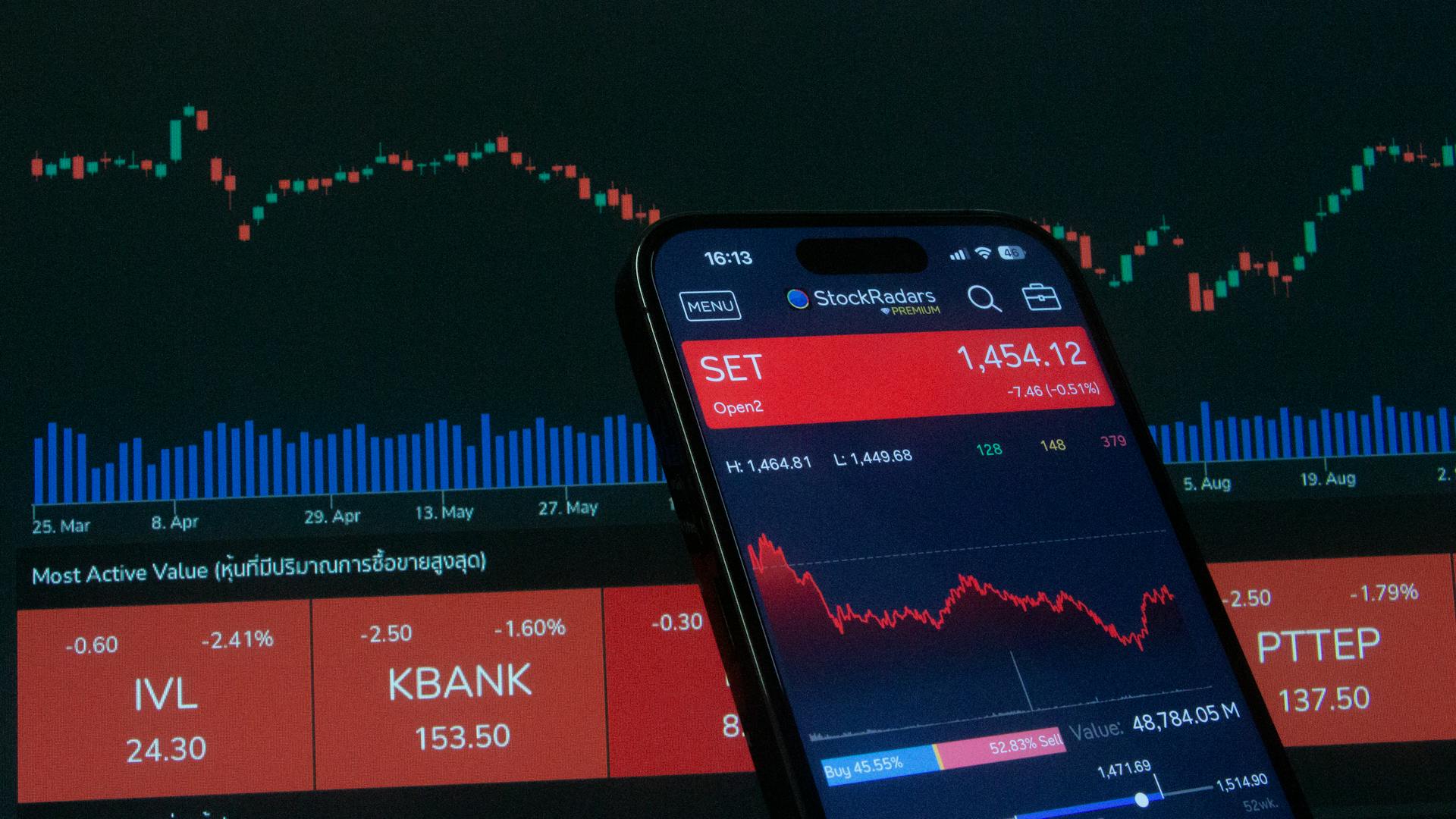
Broad money is a critical component of any economy, and understanding it is essential for making informed financial decisions. Broad money refers to the total amount of money circulating in an economy, including currency in circulation, deposits, and other liquid assets.
This concept is crucial because it affects the overall level of economic activity. For instance, an increase in broad money can lead to higher economic growth, as more people have access to money to spend or invest.
In the context of monetary policy, central banks often use broad money as a key indicator to guide their decisions. By analyzing changes in broad money, policymakers can gauge the effectiveness of their policies and make adjustments as needed.
Broad money is also closely tied to inflation, as an increase in the money supply can lead to higher prices.
You might enjoy: Increase Credit Limit Bank of America Credit Card
What Is M2?
M2 is the U.S. Federal Reserve's estimate of the total money supply, including all the cash people have on hand, plus all the money deposited in checking accounts, savings accounts, and other short-term saving vehicles such as certificates of deposit (CDs).
Broaden your view: Types of Investment Account

The Federal Reserve omits retirement account balances and time deposits above $100,000 from M2. This means that money in these types of accounts is not included in the total money supply.
M2 is different from M1, which only includes currency in people's pockets or their checking accounts and savings accounts. The money deposited in time deposits and money market funds is not counted in M1, and is instead considered "near money."
The European Central Bank considers M2, along with M3 and M4, to be part of broad money.
See what others are reading: Fdic Insurance Coverage for Business Accounts
Key Concepts
Broad money is a complex topic, but understanding the basics can be straightforward. M2 is a measure of the money supply that includes cash, checking deposits, and other deposits readily convertible to cash, such as CDs.
The difference between M1 and M2 lies in what's included. M1 only accounts for cash, checking, and savings account deposits, while M2 adds in other deposits like CDs. This distinction is important because it affects how we understand the overall money supply.
These two numbers, M1 and M2, are closely monitored as indicators of the money supply, and too-fast growth in the numbers can be a warning sign of inflation.
For your interest: Commercial Checking Account
Understanding M2

Understanding M2 is a measure of the money supply that includes cash, checking deposits, and other deposits readily convertible to cash, such as CDs. This is a more comprehensive calculation than M1 because it includes assets that are highly liquid but are not intended to be routinely used as cash.
M2 includes large-time deposits, institutional money market funds, and other large liquid assets. This is published on a quarterly basis.
The M2 money supply is closely monitored as an indicator of the overall money supply. Too-fast growth in the numbers can be a warning sign of inflation.
Here's a breakdown of the different money supply measures:
Gold is not counted in M1, M2, or M3, as it is no longer used as a common currency in the modern world. This is why the Federal Reserve constricts the money supply when the inflation rate rises—it is trying to slow down spending to control the inflation rate.
Importance of

M2 is seen as a reliable predictor of inflation, but M3 is considered an even better predictor by some economists. M3 includes data on large liquid assets held by financial institutions, making it a more comprehensive indicator.
Broad money is a key economic indicator, reflecting an economy's overall liquidity and financial health. Changes in the broad money supply can signal shifts in economic activity, inflation pressures, and potential changes in interest rates.
Central banks use information about the broad money supply to formulate and adjust monetary policy. This helps them make informed decisions about interest rates, money supply targets, and other policy measures to achieve macroeconomic objectives.
Monitoring broad money helps prevent excessive inflation or deflation, reducing the likelihood of financial crises. A well-regulated and stable money supply is crucial for economic stability.
Here are the reasons why broad money is important:
- Economic Indicator: Broad money serves as a key economic indicator, reflecting an economy's overall liquidity and financial health.
- Monetary Policy Tool: Central banks use information about the broad money supply to formulate and adjust monetary policy.
- Financial Stability: Monitoring broad money helps prevent excessive inflation or deflation, reducing the likelihood of financial crises.
- Credit Creation and Banking System Health: Broad money includes various components, such as deposits in the banking system.
- Consumer and Investor Confidence: A stable and growing money supply provides a foundation for economic activities, fostering confidence among consumers, businesses, and investors.
Current State
The current state of broad money is a complex and multifaceted issue. Broad money, which includes M1 and M2, is currently growing at a moderate pace.
Take a look at this: How Broad Can a Patent Be?

In the United States, M2 has been steadily increasing since 2020, reaching a record high of $19.7 trillion in 2022. This growth is largely driven by the expansion of deposits and other liquid assets.
The ratio of M2 to GDP has also been increasing, reaching a high of 80% in 2022. This is a significant increase from the 2008 financial crisis, when the ratio was around 60%.
The growth of broad money is not limited to the United States, as other countries such as China and the European Union are also experiencing significant increases in their broad money supply.
Curious to learn more? Check out: Benzimidazoles Broad Spectrum
Effects and Indicators
More cash out there means more cash is spent, and that can lead to inflation. A little more money can be a good thing, but a lot more can be a recipe for disaster.
The Federal Reserve constricts the money supply to slow down spending and control inflation. This is a deliberate attempt to curb excessive spending.
Inflation can be a risk when the money supply increases too much. It's a delicate balance between having enough money to spend and too much, which can lead to inflation.
The Federal Reserve's goal is to keep inflation under control, and they do this by adjusting the money supply.
Explore further: Federal Shariah Court Verdict on Interest System in Pakistan
Calculations and Trends

Decisions by central banks regarding interest rates, reserve requirements, and other monetary policy tools can impact the availability of broad money.
Tightening monetary policy can lead to a decrease in the money supply, while loosening policy can increase it. I've seen this play out in real-time during economic downturns, where central banks lower interest rates to stimulate borrowing and spending.
Economic growth and recession have a significant impact on broad money availability. During periods of expansion, there's typically increased demand for credit, leading to a rise in the money supply.
Here are some key factors that influence broad money availability:
- Monetary policy changes (interest rates, reserve requirements, etc.)
- Economic growth and recession
- Technological advances in banking
- Financial regulations (reserve requirements, banking standards, etc.)
M1 and M2 Reporting Times
The Federal Reserve releases M1 and M2 numbers every Thursday at 4:30 p.m. The St. Louis Fed tracks the numbers.
Economists usually use the broader M2 number when discussing the money supply because modern economies often involve transfers between different account types.
Businesses may periodically transfer funds between different account types, which can affect the M1 and M2 numbers.
Is M2 a Leading Indicator?

M2 is considered a reliable predictor of inflation by some economists, but it's not the only one. The Board of Governors of the Federal Reserve System notes that M3 is seen as an even better predictor of inflation.
The Federal Reserve Bank of St. Louis defines M2 as a measure of money supply. It includes data on large liquid assets held by financial institutions, which is published quarterly rather than monthly.
Some economists view M2 as a leading economic indicator, but the Board of Governors of the Federal Reserve System doesn't explicitly state this. The Board does provide information on monetary aggregates and monetary policy, but it's not clear if M2 is considered a leading indicator.
The Board of Governors of the Federal Reserve System publishes the Money Stock Measures - H.6 Release, which includes data on M2 and other monetary aggregates. This data can be useful for understanding the money supply and its relationship to inflation.
The Federal Reserve Bank of St. Louis also provides data on M2 (WM2NS), which can be used to track changes in the money supply over time.
Worth a look: First Horizon Bank Credit Data Analyst
How to Calculate?

Calculating broad money involves understanding the different monetary aggregates used to measure it.
M1 is the most basic measure, including physical currency, demand deposits, and other liquid assets.
M2 is a broader measure that includes all M1 components, plus savings deposits, time deposits with short maturity, and other liquid assets.
M3 is the broadest measure, encompassing all M2 components, plus more extensive time deposits, institutional money market funds, and other larger liquid assets.
The specific components included in each measure can vary by country and may be subject to periodic revisions by central banks or monetary authorities.
To illustrate the differences, consider the following breakdown:
Central banks and other financial institutions publish regular reports on monetary aggregates, providing insights into the overall money supply in the economy.
Trends That Affect
Tightening or loosening monetary policy can significantly impact the economy's credit level and, consequently, the money supply.
Decisions by central banks regarding interest rates, reserve requirements, and other monetary policy tools can influence the availability of broad money. This can lead to a rise or fall in the money supply.
Recommended read: Monoline Policy

During periods of economic expansion, there is typically increased demand for credit, leading to a rise in the money supply. Conversely, during recessions, reduced economic activity may result in a contraction of credit and a decrease in the availability of broad money.
Changes in technology, such as the rise of online banking, digital payments, and financial innovations, can impact how money is stored, transferred, and accessed. This can alter the composition and availability of broad money in the economic system.
Here are some key trends that can affect the availability of broad money:
- Monetary policy changes
- Economic growth and recession
- Technological advances in banking
- Financial regulations
A country's overall economic health can significantly affect broad money availability. Increased spending can occur when there is more cash in the economy, but too much can increase the risk of inflation.
Frequently Asked Questions
What is broad money M1, m2, M3, M4?
Money supply is categorized into M1, M2, and M3, with M3 being the broadest measure, including M1 components and net time deposits. M3 is also known as broad money, providing a comprehensive view of a country's money supply
What is the difference between narrow and broad money?
Narrow money is highly liquid and used for transactions, while broad money includes all types of money in an economy, reflecting the total value available to individuals and businesses. This difference affects how money is used and its overall impact on the economy.
Featured Images: pexels.com


